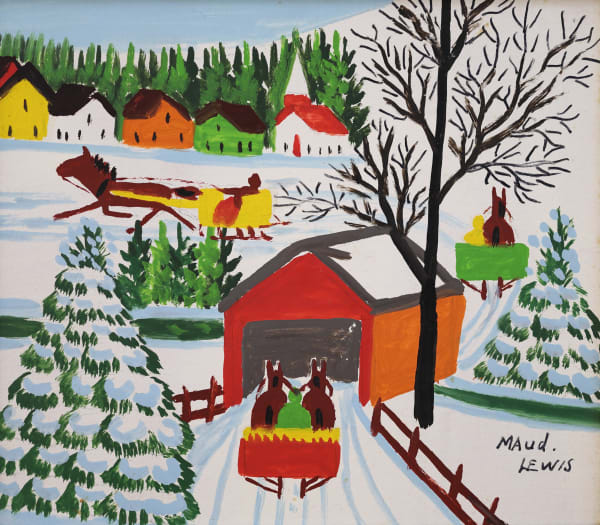Maud Lewis (March 7, 1903 - July 30, 1970) is a rare Canadian folk artist that has achieved international fame. This particularly became the case after the 2016 movie Maudie which stars Sally Hawkins and Ethan Hawke. In the true to life film, the two meet after Maud answers an advertisement Everett placed for a housekeeper in 1938. They quickly came to an understanding that Maud would join the household not as a housekeeper but as Everett's wife.
Lewis was born as Maud Kathleen Dowley in South Ohio, Nova Scotia. Despite facing physical challenges due to birth defects and later rheumatoid arthritis, Maud Lewis left an memorable mark on the world of folk art with cheerful paintings full of bright colours and iconic subjects like black cats, sleighs and cows. Her paintings were based on happy memories of the people and scenes around Yarmouth, Nova Scotia and the Digby counties.

Maud Lewis; Sleigh
Maud Lewis lived in poverty alongside her door to door fish peddler husband, Everett Lewis who also scraped by as a night watchman at the Poor Farm. Maud and Everett spent many years of their lives in a tiny white house without electricity or plumbing in Marshalltown, Nova Scotia. It was in this room house that Maud embarked on her artistic journey. After years of obscurity, Maud gained national recognition in 1964 after an article in Star Weekly. This was followed up in 1965 with a documentary on the CBC TV show Telescope. A comprehensive biography by Lance Woolaver has in turn inspired further documentary treatments.
Maud began her art career with hand-drawn and painted Christmas cards, a skill she learned from her mother. She often painted on unconventional surfaces like cardboard, particleboard, clamshells, dustpans and cookie sheets, even adorning her home's walls with her artwork. This was clever roadside marketing, as it attracted the attention of travellers. This innovative approach not only underscores Maud’s talent but also her ability to transcend the constraints of her physical condition and modest resources. In her early years, she made use of green boards and postcards, painting with whatever paint she could source from local fishermen, a testament to her determination to create art in the face of adversity.
Her vibrant, whimsical works are distinctive, frequently capturing scenes steeped in rural life such as tireless oxen and fluttering butterflies—a clear nod to the natural beauty and simple pleasures of her environment. It's within these scenes that one can feel the essence of Maud Lewis's spirit—a true convergence of courage, optimism, and a deep-seated appreciation for the world around her. Lewis's style remains a subject of fascination, with admirers drawn to the enduring charm and innocent joy that her paintings effuse.

Maud Lewis; Canada Post Stamp
Despite her physical limitations, Maud's prolific output and unchanging style endeared her to art lovers. Her paintings, often no larger than eight by ten inches, remain highly sought after. Some of her notable works include "A Family Outing," "A View of Sandy Cove," and "Portrait of Eddie Barnes and Ed Murphy, Lobster Fishermen," which achieved remarkable prices at auction.
Capturing scenes bathed in brightness and whimsy, Maud Lewis's paintings resonate with a kind of joyful innocence often lost in adulthood. Her depictions of the Nova Scotian landscape, animals, and floral arrangements hold a nostalgic charm, underscored with a distinct, optimistic thread. Maud's work, created in the face of chronic physical pain, defied her personal sufferings and emerged as a celebration of the visual joys in life.
Lewis's artistry found magic in the mundane, transforming natural pine trees into fantastical blossoms or painting winter scenes alive with the warm hues of autumn. These surreal touches introduced a dreamlike quality to her work, distinguishing it from the realism of contemporary art and likening it to the folk style of American painter Grandma Moses. Notably absent in Maud's oeuvre are scenes of indoor life or urban landscapes, focusing instead on the simplicity of rural environments.
The stark contrast between the vibrant scenes depicted and Maud's own life experiences infuses her artwork with a deeper resonance. What may first appear to be solely cheerful and colourful works of art also stand as profound expressions of hope and perseverance.
Maud's legacy extends beyond her art. Due to the efforts of The Maud Lewis Painted House Society, her home has been preserved and is now part of the Art Gallery of Nova Scotia's permanent exhibit. Additionally, a steel memorial sculpture based on her house stands at the original homesite in Marshalltown. In 2020 at Digby, Nova Scotia, Canada Post issued 3 Maud Lewis stamps including the iconic scene, "Winter Sleigh Ride".

